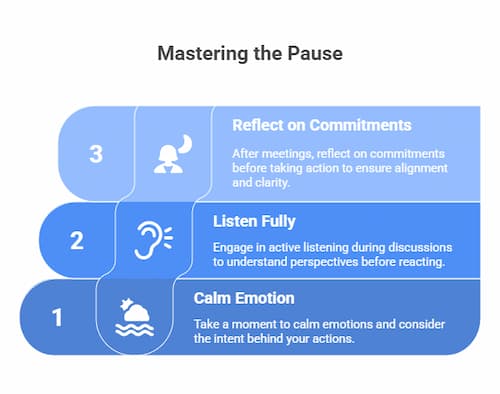Key Takeaways
- Understand the Pause: Pausing isn’t hesitation; it’s reflection that turns reaction into direction.
- Lead with Clarity: Time to think builds trust and aligns decisions with long-term goals.
- Respond, Don’t React: Emotional control begins with taking a breath before speaking.
- Create Space to Think: Teams thrive when leaders slow down enough for everyone to contribute.
- Practice Daily: Consistent reflection turns the pause into a leadership habit that builds composure.
When Fast Starts Become False Starts
Speed often looks like the mark of good leadership. Acting quickly can inspire confidence and energy, but when pace replaces purpose, clarity slips away. What begins as momentum can quietly turn into confusion.
At SentinelWave, a mid-sized company, that pattern had reached a breaking point. Decisions came fast, but coordination fell behind, leaving projects tangled and teams exhausted. Speed was winning, but progress was not.
When deadlines began to slip, the executive team met to understand what went wrong. For once, they slowed down long enough to see that their agility had become reaction. The issue was not effort or talent, but the absence of pause.
What happened in that room applies to every leader, no matter what the industry. They learned that reflection steadies decisions, rebuilds trust, and restores confidence when change feels constant. The strongest leaders are not the fastest, but the ones who know when to stop and think.
What they discovered next offers valuable lessons for any leader trying to find clarity in the rush to decide.
Understanding Why the Pause Matters
Leaders make decisions constantly, but few stop to consider how speed shapes those choices. A pause brings clarity and steadiness, guiding action with purpose instead of urgency. True leadership sees reflection as progress, not hesitation.
When the meeting began, the Operations Director admitted, “We’ve been treating quick decisions like a badge of honor.” Around the table, heads nodded as others recalled moments when rushing ahead led to confusion and rework.
The group realized that reflection was not wasted time; it was the guardrail for good judgment. They discussed how brief pauses before key decisions could have prevented costly missteps. A short pause, they agreed, can:
- Prevent emotional overreaction in moments of pressure.
- Offer time to gather missing context or information.
- Allow space to involve others before committing.
- Lead to clearer, more defensible outcomes.
Seeing the pause as progress helps leaders act with purpose instead of pressure. Reflection turns reaction into direction and builds the habit of thoughtful decision-making. That awareness sets the stage for knowing when a pause truly matters.
Recognizing When to Pause
Knowing the value of reflection is one thing; knowing when to pause is another. Some decisions need immediate action, while others demand time to breathe. Timing a pause well can mean the difference between acting with clarity and reacting out of habit.
During the discussion, a Project Manager leaned forward. “I can think of at least three meetings where I spoke too soon,” she said. “If I had waited even a minute, we could have avoided a few unnecessary arguments.”
Her honesty gave the group pause. They began identifying specific moments where quick responses had caused friction or miscommunication. Pausing, they found, often fits best in three moments of decision:
- Before responding, calm emotion and consider intent.
- During discussion, listen fully before reacting.
- After key meetings, reflect before acting on commitments.
Recognizing these patterns helps leaders stay thoughtful instead of reactive. Knowing when to pause strengthens judgment, collaboration, and trust. That awareness naturally leads to understanding how pauses build psychological safety.

Recognizing How the Pause Builds Safety
Every leader wants open dialogue, but quick decisions can make people hold back. When people fear that decisions are made too quickly, they stop contributing. A pause tells the room that listening matters as much as speaking.
Later in the meeting, the Director of Human Resources spoke softly. “We have been answering so fast that people stopped sharing their opinions,” she said. “If we paused more often, our teams might feel like their voices really matter.”
The group reflected on how their pace had shaped the company culture. Their good intentions had unintentionally shut people down. They realized that pausing could encourage several trust-building dynamics:
- Psychological safety, by showing that all voices matter.
- Curiosity, by signaling genuine interest in others’ ideas.
- Inclusion, by giving time for diverse perspectives.
- Respect, by showing that silence can mean consideration, not disinterest.
When leaders create space for dialogue, trust and innovation grow together. That culture of openness sets the tone for emotional steadiness, helping leaders manage reactions when tension rises.
Exploring How the Pause Improves Emotional Control
Leadership often demands composure in moments that test patience. Under pressure, it’s easy to rush decisions to escape discomfort. Pausing gives space to breathe, listen, and choose words more carefully. It’s the difference between reacting from emotion and responding with awareness.
Midway through the meeting, the Chief Financial Officer smiled ruefully. “I can admit it, I have reacted defensively to feedback more than once,” she said. “If I had paused, I might have heard what people were actually saying instead of what I assumed they meant.”
Her candor sparked a thoughtful silence. Others admitted they had done the same, jumping to defend instead of listening to understand. Reflection revealed that emotional control improves when leaders:
- Allow emotion to rise and settle before responding.
- Use silence to process, not suppress, their reactions.
- Ask clarifying questions rather than defending immediately.
- Reframe feedback as data, not personal judgment.
Leaders who master emotional steadiness set a tone of calm that shapes the entire organization. The ability to pause under pressure transforms awareness into resilience, which naturally explains why slowing down can feel so difficult in modern work environments.
Addressing Why Slowing Down Feels Hard
Most organizations reward speed. Leaders fill calendars, answer messages immediately, and mistake activity for progress. Slowing down can feel like breaking a rule, even when it’s the smartest thing to do.
As the conversation deepened, the Chief Operating Officer exhaled. “We built a culture that rewards quick answers,” he said. “No one wants to be the person who says, ‘Let’s think about it.’ We made speed the goal instead of accuracy.”
That realization struck a chord. The team discussed how structure, not just mindset, had created barriers to reflection. Common obstacles to slowing down include:
- Packed calendars that leave no space to think.
- Communication overload that rewards fast replies.
- Overlapping priorities that create constant urgency.
- Metrics often measure activity, not the quality of outcomes.
The modern workplace often equates pace with value, but sustainable leadership depends on rhythm, not speed. Shifting from constant motion to intentional reflection takes courage and consistency, and it begins with shared habits that reinforce calm thinking.
Turning Reflection Into a Shared Habit
Reflection grows stronger when it becomes a shared habit. When teams pause together, conversations slow just enough for better ideas to surface. These moments do not stop progress; they strengthen it by building trust, alignment, and focus.
As the meeting drew toward its close, a Senior Team Lead spoke up. “Our teams mirror what they see,” she said. “If we never pause, they won’t either. What if we start every meeting with a few seconds of quiet?”
That suggestion sparked a creative discussion. The group considered ways to normalize reflection, including:
- Starting meetings with a brief moment of silence.
- Holding quick post-project reflections or check-ins.
- Allowing anyone to call for a pause during tense moments.
- Recognizing team members who model thoughtful responses.
When reflection becomes shared, collaboration deepens and mistakes decrease. The pause transforms from a leadership technique into a cultural value. This mindset naturally leads to the question of how to make reflection a daily practice.
Practicing the Pause Every Day
Reflection only becomes a habit through repetition. Leaders do not need elaborate routines; they need small, steady moments that keep clarity within reach. Practice is what transforms intention into instinct.
As the meeting wound down, the Chief Executive Officer smiled. “If each of us just takes a breath before we speak, everything about how we lead will change,” she said. “That one second could shift the tone of this whole company.”
The team nodded, recognizing that consistency mattered more than scale. Common ways to practice pausing throughout the day include:
- Taking five seconds before responding to complex questions.
- Walking briefly between meetings to clear mental space.
- Pausing before hitting “send” on important messages.
- Reflecting for a few minutes before making key decisions.
When reflection becomes part of daily rhythm, it grounds leadership in awareness rather than urgency. That habit of presence prepares organizations to adapt with calm confidence when challenges return.
When Pausing Changes the Pace
The art of leadership isn’t about speed but about thoughtfulness. When leaders take time to think, listen, and reflect, they replace reaction with purpose. The pause isn’t a slowdown; it’s the moment that strengthens direction and quality.
Six months later, SentinelWave’s culture showed the impact. Meetings felt calmer, decisions clearer, and collaboration more natural. Progress returned, not from pushing harder, but from pausing long enough to think together.
The pause became their quiet advantage, the bridge between intention and action, pressure and purpose, speed and stability. It’s an advantage any organization can cultivate when it chooses to value reflection as much as execution.
True leadership isn’t measured by motion but by clarity. A pause creates space for trust, purpose, and composure to grow. Thinking before acting models confidence that steadies teams through constant change.
At Watermark Learning, we help leaders strengthen clarity, composure, and decision-making through reflective leadership training. Our programs turn the simple act of pausing into a repeatable skill that improves performance and builds trust.
Partner with Watermark Learning to help your leaders pause with purpose, think strategically, and lead with confidence.
Jay Pugh, PhD
Dr. Jay Pugh is an award-winning leader, author, and facilitator with over 18 years of teaching and training experience. Currently serving as Head of Leadership Growth at Educate 360, he leads a robust team of external and internal facilitators who specialize in developing leadership capabilities within medium and large-scale businesses. His team works directly with business professionals, helping them become more effective leaders in their daily operations.
Dr. Pugh holds a Ph.D. in Instructional Management and Leadership, and his academic contributions include two published articles and a dissertation focusing on various educational topics. His extensive experience and academic background have established him as a respected voice in leadership development and educational management.

 New Horizons
New Horizons
 Project Management Academy
Project Management Academy
 Six Sigma Online
Six Sigma Online
 Velopi
Velopi
 Watermark Learning
Watermark Learning
 Login
Login





 New Horizons
New Horizons
 Project Management Academy
Project Management Academy
 Velopi
Velopi
 Six Sigma Online
Six Sigma Online
 Watermark Learning
Watermark Learning